ShodhKosh: Journal of Visual and Performing ArtsISSN (Online): 2582-7472
|
|
A STUDY ON CONSUMER BEHAVIOUR OF URBAN INDIAN WORKING WOMEN TOWARDS OFFICE WEAR OUTFITS AND SUSTAINABLE FASHION
Vandana Tripathi Nautiyal
1 ![]()
![]() ,
Dr. Avadhut Atre 2
,
Dr. Avadhut Atre 2 ![]()
![]()
1 Research
Scholar, Faculty of Art and Design, Vishwakarma University, Pune, India
2 Professor,
Faculty of Art and Design, Vishwakarma University, Pune, India
|
|
ABSTRACT |
||
|
The lifestyle of today’s urban consumers has dramatically changed due to various reasons which has led to a shift in their needs, preferences, and attitudes towards various product s in their day-to-day life. The urban working women’s entering the corporate workforce in India is increasing day by day. The increasing number of urban working women has led to demand of clothing appropriate for the workplace. Indian Urban women working in Corporates are opting right business attire as it gives them a serious image at their workplace with respect to their male counterparts. Also, in recent time there has been a surge in demand for sustainable products due to growing awareness of sustainable practices amongst Indian consumers. The purpose of this study is to understand the workplace clothing need and preference of urban women working in corporates. The research also tries to understand the attitude of such women towards sustainable fashion. A clear understanding of consumer behavior of urban Indian working women will help sustainable fashion marketers to attract and maintain their target consumer segment. The study is based on notable past research and two set of questionnaire surveys followed by subsequent data analysis. The findings suggest a scope for sustainable western business casual wear as a preferred choice of clothing in work environments among a new emerging class of women in urban India. |
|||
|
Received 04 June 2022 Accepted 29 August 2022 Published 02 September 2022 Corresponding Author Vandana
Tripathi Nautiyal, textilevandana@gmail.com DOI 10.29121/shodhkosh.v3.i2.2022.152 Funding: This research
received no specific grant from any funding agency in the public, commercial,
or not-for-profit sectors. Copyright: © 2022 The
Author(s). This work is licensed under a Creative Commons
Attribution 4.0 International License. With the
license CC-BY, authors retain the copyright, allowing anyone to download,
reuse, re-print, modify, distribute, and/or copy their contribution. The work
must be properly attributed to its author.
|
|||
|
Keywords: Sustainability, Working Women, Consumer Behavior |
|||
1. INTRODUCTION
India is one of the world’s largest growing economy and market across the globe. The Indian landscape is urbanizing at a very rapid pace which is enormously changing the lifestyle, consumption preferences and buying behaviour of Indian consumers. This reflects a change in consumer’s way of living, values, attitudes, opinions, interest and various other behavioural aspects. The increased consumer awareness and higher disposal income leads to growing urbanized lifestyle. In case of women’s in India who are becoming financially independent and are not just playing role as housewives but also finding space in male dominated boardrooms of corporates. They are breaking societal barriers, stereotypes and patriarchal oppression. Their status is emerging, becoming contemporary and they are living in present. This reflects in the lifestyle of modern Indian women who as a consumer are more evolved and informed about their consumption preference and buying behaviour.
A large number of women in urban India are employed in corporates and leading them. In urban India, women participation in the workforce is in impressive numbers Singh and Hoge (2010). India ranks third in the world for women working in senior management positions, according to the Women in Business 2021 report by global accounting and consulting firm Grant Thornton Grant Thornton (2021, March 03). Today Indian working women due to change in their behaviour as a consumer are concerned about how they look at workplace and are ready to experiment and does not want to lag behind in this fashion era even being at office. Increasingly, they are opting for appropriate business attire as it gives them a serious image. In case of meetings with top executives or clients, they want to be taken seriously, at par with their male counterparts.
Work wear clothing for Indian women is now not only confined to traditional Indian wear options of a Saree, Salwar suit or Kurtis but it has range of choices in western styles and silhouettes suitable as work wear. The western work wears have become a part of urban Indian working women’s wardrobe and reflect’s her contemporary taste, adoption of global trends and modern lifestyle. As per Pooja Khanna –Founder Venn “There has been an overall lifestyle change which has led to a change in preferences in the type of clothes women are choosing. This coupled with high disposable income, easy access and awareness to e-commerce and social media has led to the rise of the formal wear segment in India,” Sharma (2019, August 30).
2. Sustainable Fashion
Sustainability is a pressing issue in today’s time. The growth in ethical consumption behaviour and greater interest in sustainable fashion from a production side provides grounding for the emergence of a new consumer market for sustainable fashion Lundblad and Davies (2015). Globally there is a shift happening in a set of consumers where they are trying to adopt sustainable practices. Today consumers are primarily making conscious clothing decisions and gradually heading towards sustainable fashion Nupur (2018, April 1). Studies have suggested that consumers have been showing increasing levels of ethical concerns in the context of fashion consumption Niinimäki (2010). Despite the fairly good demand from consumer side and supply from brand/manufacturers side, the success rate of sustainable fashion is moderate. There is a dire need to bring in more awareness towards sustainability amongst consumers and push consumers towards consuming fashion sustainability. The realization that no transparent companies are most likely not producing their goods in a sustainable way is an excellent beginning towards encouraging consumers to explore more sustainable options on the market; with the emergence of a new fashion sector there also needs to be a new, multi-faceted marketing approach to develop a stronger, more positive relationship between consumers and brand explicitness, credibility, and quality Kutsenkova (2017).
3. Method
The aim of the study is to understand the workplace clothing needs and preference of urban women working in corporates. The research also aims to understand the attitude of such women towards sustainable fashion. The data for the study was obtained from various secondary sources like journals, internet articles, books etc. where some notable works have been studied to understand the status quo in the given context. Primary data collection has been collected from two round of questionnaire survey.
The objective of first survey was to study the clothing need and preference of urban women working in corporates. The questions included in the survey reflected upon the demographics of the respondents. It also included questions to understand the problems associated with work wear for corporate urban women and their preference and satisfaction with the current available sustainable fashion clothing options in the market.
The objective of second round of survey was to understand the attitude of such women towards sustainability. The questions included in second round of survey reflected upon the awareness level of consumers towards sustainable fashion and their liking and disliking towards sustainable fashion. It also aimed to understand the motives to purchase suitable fashion. Both the surveys were semi structured to allow answers which were based on behaviour of the responded and were subjective in nature. In the second round of survey an introductory reference note on Fashion sustainability was also shared amongst the respondents. A total number of 229 survey forms were floated amongst the urban Indian working women out of which 148 responded to both the surveys.
The data from the survey was subjected to statistical analysis and interpreted as results from the research. The findings from the study will further help the researcher to plan and develop a range of sustainable business attires for urban women’s working in corporates. Also, the findings suggest to the sustainable fashion marketers to attract and maintain their target consumer segment.
The sample for the study was drawn conveniently from the population of urban working women in corporate business from Pune, India location. Convenience sampling is selected as it is the most basic form of non-probability sample. Total 229 individuals were approached via online survey forms for the round of questionnaire survey. 148 number of individuals participated in both the surveys.
4. Results and Discussions
In the first round of survey the
demographic data illustrated the charachterstics of the population to further
predicit the suitable consumer profile and market segement for urban Indian
working women clothing catagory.
The age group division percentage
of respondents were as – 4% were from 18-24 years, 20 % were from 25-30 years,
40% were from 31-35 years , 28% were from 36-40 years and 8% were from 40-above
years age group Figure 1.
To underdstand the diversity in
type of employment it was found that 32% respondents were working with MNC’s,
24% were educators, 25% were startup women professional , 8% were govt job employees,
6% were in banking jobs and 5% were employed in some other types of professions
Figure 2.
Figure 1

|
Figure 1 Age Group of Respondents |
Figure 2

|
Figure 2 Profession of
Respondents |
The annual income for 46% of
respondents were upto 12 lakh p/a , 32% of respondents were upto 6lakh p/a, 14%
of respondents were above 24Lakh p/a and 8% of respondents were upto 24 Lakh
p/a Figure 3.
Figure 3

|
Figure 3 Annual Income of Respondents |
The level of management heiarchy
of the respondents in percentage were
58% were at the Beginner Level of
Management, 24% were at the Mid level of Manamengt, 18% were at the Top level of Management Figure 4
Figure 4
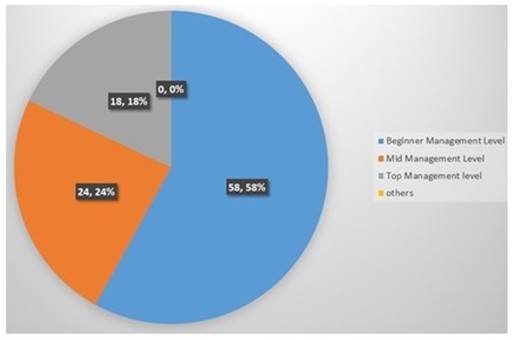
|
Figure 4 Management Level of Respondents |
The data outcomes for preferred choice of clothing
category for work were -44% of respondents preferred Western wear outfits, 32%
of respondents preferred Indian wear outfits and 24 % of respondents preferred
Indo western wear outfits. This reflects upon that a majority of urban Indian
working women prefer to wear western wear outfits at work. They
are comfortable and confident in western wear outfits. Indian wear outfits are
more preferred clothing choice over Indo-western wear outfits Figure 5.
Figure 5
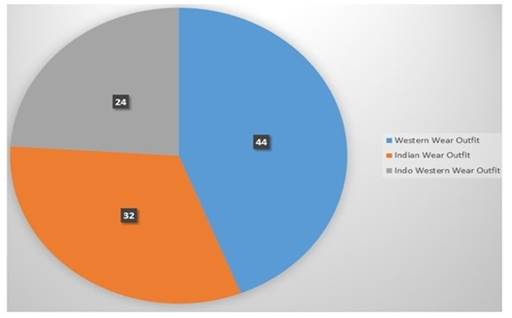
|
Figure 5 Preferred Choice of Clothing
for Work |
Also 42 % of urban Indian working women prefer trendy casual yet decent shirt and trouser/skirt over the other
choice of outfits asked like formal saree, Kurta legging, western dresses etc. Figure 6.
Figure 6
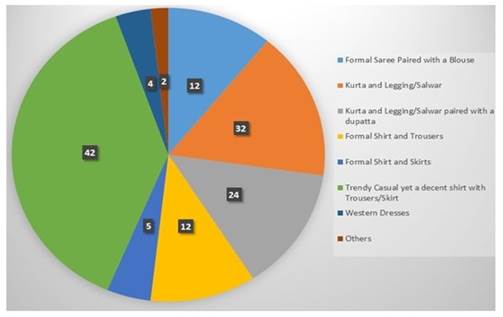
|
Figure 6 Most Preferred
Garment Pair for Work |
A set of open ended questions were
asked to understand the problem faced by individual urban Indian working
women when buying western or indo western office
wear. Majority of the respondents faced the problem of unavailability of
suitable western or indo western wear clothing for
work. Few of them also faced the size and fit issues. It was also found that
most of them wear unbranded or local branded and locally customized western or indo western office wear outfits. Quality, price, and
design were the top features that most of the respondents prefer while they
shop for western or indo western office wear. The brand preference given by the respondents was very
varried list of different brands of local, National and International level.
The second round of survey was attitudinal survey to understand urban
Indian working women awareness, perceptions, emotions, feeling, attitudes towards sustainable
fashion. According to 30% of respondent’s sustainable fashion means recycled
cloths, 29% responded these are overpriced cloths,18% responded that
sustainable fashion cloths has less trendy designs, 12% responded they are
quality, durable and long lasting fashion products, 8% responded sustainable
clothes are made from less chemicals used in the process and 3% associate it
with fair labour in the production process Figure 7. Also, it was
found that 67% of the respondents were concerned about Social, Environmental
and Ethical impact from Fashion Industry on the world while 32% were not
concerned about the impact Figure 8.
Figure 7

|
Figure 7 Meaning of Sustainable
Clothing |
Figure 8
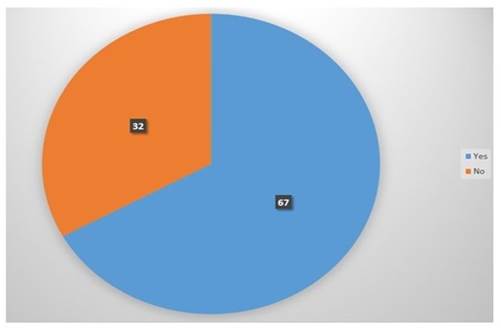
|
Figure 8 Concern About Social, Environmental and Ethical Impact from Fashion Industry on the World |
83% of respondents were ready to buy sustainable fashion Figure 9. 65% of the respondents were ready to buy sustainable Fashion at the same price as of normal Fashion. 26% were ready to pay more for sustainable fashion products as compared to normal Fashion. 6% respondents answered they will only buy sustainable fashion if it is cheaper than normal Fashion and 3% responded that they will not buy sustainable Fashion at all Figure 10
Figure 9
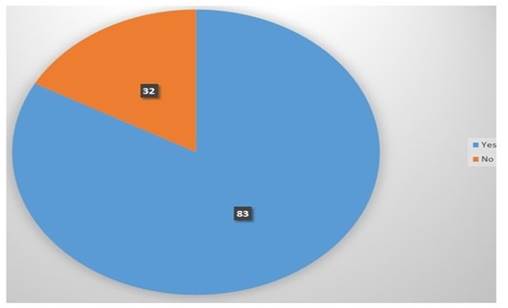
|
Figure 9 Buying Sustainable Apparels |
Figure 10
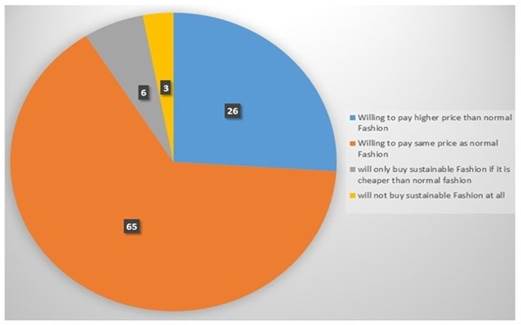
|
Figure 10 Willingness to Purchase Sustainable Fashion |
It was found that 26% of the respondents will Prefer to
pay 5-10% more for Sustainable Fashion as compared to normal Fashion, 32% of
the respondents will Prefer to pay 11-20% more for Sustainable Fashion as
compared to normal Fashion, 31% of the respondents will Prefer to pay 20-30% more
for Sustainable Fashion as compared to normal Fashion, 3% of the respondents
will Prefer to pay 30-40% more for Sustainable Fashion as compared to normal
Fashion, 2% of the respondents will Prefer to pay 40% and above for Sustainable
Fashion as compared to normal Fashion
and 6% of the respondents will Prefer not to pay more for Sustainable Fashion
as compared to normal Fashion Figure 11 Factors like material, quality and price
were the Top three encouraging factor to buy more/pay more for Sustainable
Fashion out of all the factors like price, quality, style, material and eco
Friendly concept Figure 12
Figure 11
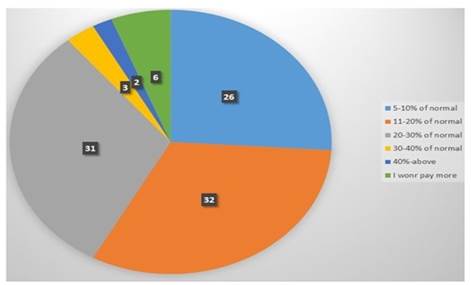
|
Figure 11 Preference to Pay More for Sustainable Fashion in Percentage |
Figure 12
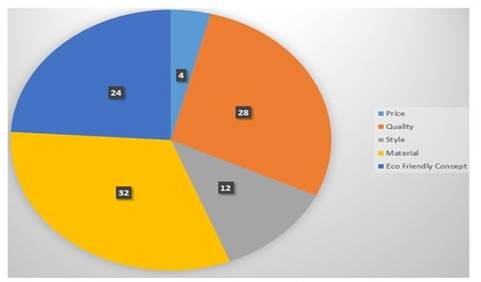
|
Figure 12 Top Encouraging Factor to Buy More/Pay More for Sustainable Fashion |
As per the survey results it can be seen
that women’s western office wear category has potential to grow as there
is existence of demand and supply gap within this category. More number of Women from urban Indian are
employed and had disposable income to spend on office wear outfits appropriate for them to wear at their
workplaces. The results suggest that a majority of urban Indian working women prefer to wear western wear outfits at work. It can be
predicted that women’s western office wear is bigger market with high and
growing demand.
Also, it can be drawn from second survey that Urban Indian women’s are becoming more conscious of the impacts of where and how they shop for clothes especially the younger generation like Gen z and late millennials. This presents an opportunity for the Indian fashion industry to reiterate how can it become sustainable. The consumers have already begun changing their behaviours towards sustainability which reflects in their lifestyle choices. A large number of consumers wants to practice sustainability in their Fashion choices and to some extent they are also ready to pay more for it. In such cases the women’s western office wear brands need to offer sustainable material choices in high quality and at better prices.
CONFLICT OF INTERESTS
None.
ACKNOWLEDGMENTS
None.
REFERENCES
Grant Thornton (2021, March 03). Women in Business - India Ahead of Global Average : Grant Thornton’S Global Research.
Kutsenkova, Z. (2017). The Sustainable Future of the Modern Fashion Industry. (Honors Theses. 21). Dominican University of California. https://doi.org/10.33015/dominican.edu/2017.HONORS.ST.02.
Lundblad, L. and Davies, I. A. (2015). The Values and Motivations Behind Sustainable Fashion Consumption. Journal of Consumer Behaviour, 15(2), 149-162. https://doi.org/10.1002/cb.1559.
Niinimäki, K. (2010). Eco-clothing, Consumer Identity and Ideology. Sustainable Development, 18(3), 150-162. https://doi.org/10.1002/sd.455.
Nupur, (2018, April 1). Feel-Good Fashion. Times Life. TOI 1–4.
Sharma, R. (2019, August 30). The Changing Definition of Women’s Formal Wear in India.
Singh, S. and Hoge, G. (2010). Debating Outcomes for "Working" Women: Illustrations from India. Journal of Poverty, 14 (2), 197–215. https://doi.org/10.1080/10875541003711821.
|
|
 This work is licensed under a: Creative Commons Attribution 4.0 International License
This work is licensed under a: Creative Commons Attribution 4.0 International License
© ShodhKosh 2022. All Rights Reserved.

